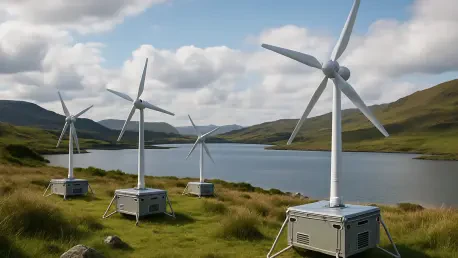Imagine a world where clean, reliable power is no longer tethered to sprawling wind farms or sun-soaked solar arrays, but instead flows directly from the nearest river with a device no larger than a small boat. This vision is becoming a reality through the advent of portable hydrokinetic turbines, a technology that harnesses the steady currents of shallow waters to generate electricity without the constraints of weather or massive infrastructure. Developed by innovative companies like Idénergie based in Montreal, these compact systems are challenging the status quo of renewable energy by offering a consistent and sustainable alternative. As the global demand for clean energy intensifies, the potential of water-powered solutions to fill critical gaps left by solar and wind technologies is sparking interest among environmentalists, engineers, and policymakers alike. This article delves into the promise of portable turbines, exploring their technological edge, practical benefits, and the hurdles they must overcome to reshape the renewable energy landscape.
Breaking New Ground in Clean Power
Harnessing Water’s Untapped Potential
The concept of generating electricity from water is far from new, but portable hydrokinetic turbines represent a significant leap forward in accessibility and efficiency. Unlike traditional hydroelectric dams that require vast resources and alter ecosystems, these innovative devices tap into the natural flow of rivers with minimal environmental disruption. A standout example is the turbine developed by Idénergie, which can produce up to 12 kWh daily—rivaling the output of multiple solar panels—in a compact, modular design. This reliability stems from water’s constant availability in many regions, offering a stark contrast to the intermittent nature of sunlight and wind. For communities near rivers or streams, this technology provides a steady power source that operates 24/7, unaffected by cloudy skies or calm days. The shift toward water as a primary energy resource could redefine how remote and rural areas access electricity, reducing dependence on fossil fuels and weather-dependent renewables.
Overcoming Limitations of Traditional Renewables
While solar panels and wind turbines have driven remarkable progress in the renewable sector, their limitations are increasingly evident in regions with inconsistent weather patterns. Portable water turbines address this gap by delivering consistent energy output regardless of external conditions. Their ability to function in shallow waters with low flow speeds—less than a meter deep—makes them adaptable to a wide range of geographic settings. Additionally, the environmental footprint of these systems is notably small, with designs like Idénergie’s incorporating features such as the Darrieus-type rotor to minimize harm to aquatic life. Constructed from recyclable materials like aluminum, these turbines align with sustainability goals while offering a practical solution for individual households or small communities. This adaptability positions water-powered systems as a complementary force in the broader renewable energy mix, capable of addressing specific challenges that solar and wind technologies cannot fully resolve.
Practical Impacts and Future Challenges
Economic and Installation Advantages
One of the most compelling aspects of portable hydrokinetic turbines lies in their user-friendly design and economic benefits over time. These systems are engineered for simplicity, often shipped disassembled and requiring just a few steps to set up, whether by a homeowner or a professional. This ease of installation eliminates the need for extensive infrastructure, making the technology accessible to diverse users, from rural farmers to off-grid enthusiasts. Economically, the turbines offer significant savings compared to traditional gasoline generators, with maintenance costs often reduced by half due to innovative features like waterproof, shaftless designs and remote monitoring capabilities. Despite a steep initial investment—often around $10,000 USD—the long-term reduction in operational expenses presents a strong case for adoption. As manufacturing scales and designs are refined, the potential for cost reductions could further democratize access to this promising technology.
Navigating Barriers to Widespread Adoption
Despite their advantages, portable turbines face notable hurdles that could temper their immediate impact on the renewable energy market. The high upfront cost remains a significant barrier for many potential users, particularly in developing regions where access to financing may be limited. Additionally, regulatory challenges often complicate deployment, as local approvals are typically required before installation, and these processes can vary widely by jurisdiction. Concerns about market presence and ongoing support also linger, with some companies showing limited public engagement or updates in recent years, raising questions about long-term reliability and customer service. Addressing these issues will be critical to scaling adoption and ensuring that water-powered systems can compete with more established renewable technologies. Collaborative efforts between innovators, governments, and financial institutions could play a pivotal role in overcoming these obstacles and unlocking the full potential of this emerging field.
Reflecting on a Sustainable Path Forward
Building a Diversified Energy Future
Looking back, the journey of portable hydrokinetic turbines marked a pivotal moment in the quest for sustainable power solutions. Their ability to harness river currents with minimal environmental impact offered a refreshing counterpoint to the intermittency of solar and wind energy, paving the way for more resilient systems. By providing consistent electricity in areas with access to flowing water, these compact devices empowered communities that were previously reliant on costly or polluting alternatives. The technological strides made by companies in this space demonstrated that innovation could thrive outside the realm of large-scale infrastructure, bringing power generation closer to the people who needed it most. As the renewable sector evolved, the integration of water-powered solutions into a broader energy portfolio stood as a testament to the value of diversity in addressing global energy challenges, ensuring that no single technology bore the burden alone.
Charting the Next Steps for Innovation
Reflecting on past efforts, the path ahead for portable turbines became clear through a focus on actionable progress. Overcoming the barriers of cost and regulation demanded targeted solutions, such as subsidies or streamlined approval processes to encourage adoption. Partnerships between technology developers and local governments proved essential in navigating these challenges, ensuring that communities could benefit from clean energy without undue burden. Meanwhile, continued investment in research and development held the key to refining designs, enhancing efficiency, and further reducing environmental impacts. Encouraging dialogue among stakeholders—ranging from engineers to policymakers—fostered an environment where water-powered systems could flourish alongside other renewables. By prioritizing accessibility and sustainability, the legacy of these turbines was one of empowerment, offering a blueprint for how innovation could transform the energy landscape in meaningful, lasting ways.









